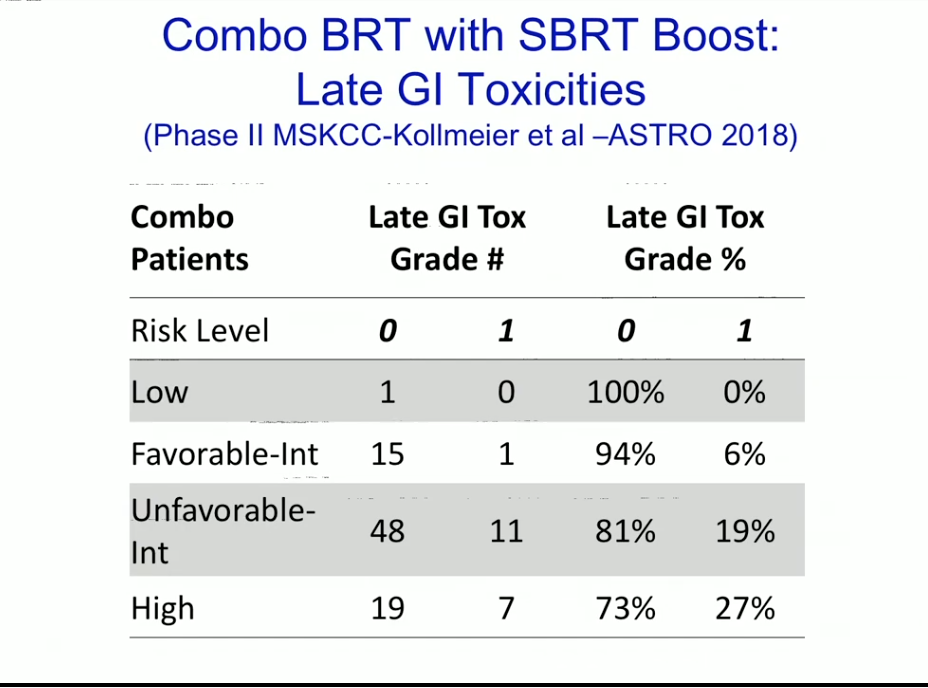Michael J. Zelefsky, MD, presented “Combining SBRT and Brachytherapy in Higher Risk Prostate Cancer” during the 24th Annual Southwest Prostate Cancer Symposium on April 12, 2019 in Scottsdale, Arizona.
How to cite: Zelefsky, Michael J.. “Combining SBRT and Brachytherapy in Higher Risk Prostate Cancer” April 12, 2019. Accessed May 2025. https://grandroundsinurology.com/combining-sbrt-and-brachytherapy-in-higher-risk-prostate-cancer/
Combining SBRT and Brachytherapy in Higher Risk Prostate Cancer – Summary:
Michael J. Zelefsky, MD, argues that combining stereotactic body radiation therapy (SBRT) with low-dose rate brachytherapy can help to reduce the morbidities of combined-modality radiotherapy. He also emphasizes the need to address the issue of toxicity with careful patient selection, treatment planning, and adherence to tight dose constraints.
Abstract:
Combining external beam radiation therapy (EBRT) with brachytherapy, a form of combined-modality radiotherapy (CMRT), is the most potent local therapeutic intervention physicians have to address locally advanced prostate cancer. CMRT has superior tumor control outcomes compared to EBRT alone.
Despite outstanding results, CMRT has not gained traction as a primary treatment due to toxicity concerns. Many practitioners would prefer to only recommend EBRT plus androgen deprivation therapy (ADT) as the standard regimen.
However, rather than avoiding CMRT, the medical community should address these morbidity concerns through meticulous care, better patient selection, improved dose planning with MRI visualization, the utilization of technology such as rectal spacers, and adherence to tight dose constraints.
Other possible methods of reducing these morbidities that are under consideration include the use of SBRT with brachytherapy, as well as testosterone annihilation plus SBRT.
Additionally, CMRT has the ability to provide local dose escalation to a dominant lesion, rather than treating the entire gland. Focusing radiation on the dominant intraprostatic lesion (DIL), which is the most common site of local recurrence, could enhance tumor control. Recent technological advances in diagnostic imaging and radiation techniques allow for the facilitation of dose escalation in these dominant nodules.
About the Southwest Prostate Cancer Symposium
The Southwest Prostate Cancer Symposium (SPCS) is a multi-day conference that seeks to educate urologists, radiation oncologists, medical oncologists, and other healthcare professionals involved in the treatment of prostate cancer. The topics focus on current technical aspects of diagnosis and treatment of localized and advanced disease, particularly regarding imaging, technology, and training in the related devices. Dr. Zelefsky presented this lecture during the 24th SPCS in 2019. In 2020, the 25th SPCS will also offer training sessions involving imaging, scanning, and prostate cancer treatment-related devices on site. Please visit this page in order to register for future SPCS meetings.
ABOUT THE AUTHOR
Michael J. Zelefsky, MD, is Professor of Radiation Oncology and the recipient of the Greenberg Chair for Prostate Cancer Research at Memorial Sloan Kettering Cancer Center in New York City. He is a board-certified radiation oncologist and co-leader of Memorial Sloan Kettering’s Genitourinary Disease Management Team, a multidisciplinary group of physicians who work together to treat patients with urologic malignancies. As a recognized expert in the field of radiation therapy, Dr. Zelefsky is Chief of Memorial Sloan Kettering’s Brachytherapy Service.
The prostate brachytherapy program at Memorial Sloan Kettering, which Dr. Zelefsky helped develop and enhance since joining the staff in 1990, is known for its depth of experience and cutting-edge approach in treating men with prostate cancer. For patients with advanced or aggressive prostate cancer, he has significant expertise using high-dose-rate brachytherapy and temporary brachytherapy, in which patients receive several high-dose treatments either as a boost or as the sole treatment. Dr. Zelefsky also has experience using brachytherapy in patients whose tumor has recurred after external-beam radiation therapy or seed implant, as well as expertise using image-guided stereotactic radiosurgery for areas of metastases (spread) such as bone or lymph nodes.
In addition, Dr. Zelefsky was instrumental in pioneering the use of IMRT (intensity-modulated radiation therapy, which is computer-guided delivery of high doses of radiation directly to the tumor) and IGRT (image-guided radiotherapy, radiation beams targeted precisely to the tumor) for treating men with prostate cancer. He is Editor-in-Chief of Brachytherapy, a medical journal that addresses all aspects of this sub-specialty. He is also a past president of the American Brachytherapy Society.
For his work in this field, Dr. Zelefsky has been honored to receive several awards including the Boyer Award for Excellence in Clinical research, the Outstanding Teaching Award in the Department of Radiation Oncology at Memorial Sloan Kettering, the 2009 Henschke Medal (the highest award of the American Brachytherapy Society for achievements in Brachytherapy), and the 2009 Emanuel Van Descheuren Award for Excellence in Translational Research.

